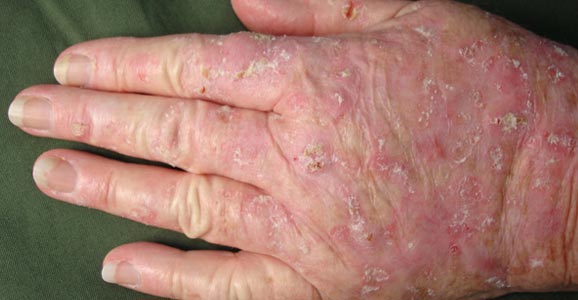5-Fluorouracil (Efudex) is a cream that is commonly used to treat sun changes on the skin that are precancerous. These precancerous changes are called actinic keratoses. Actinex or Fluoroplex are two other brand creams that can also be used.
There are many ways to treat actinic changes. Freezing (cryotherapy) is often performed with either liquid nitrogen or nitrous oxide. If there is only a spot or two, this works very well. Lesions can also be cut out with a scalpel. However, when the changes are extensive and cover many areas of the forehead or the scalp, then it is better to use a cream.
5-Fluorouracil as a liquid can be injected intravenously to treat internal cancers. So, using this cream on the skin is a type of chemotherapy. When destroying the abnormalities on the skin, the cream can make the skin very raw. It can ulcerate and also ooze. It may dry out and feel very tight. However, it will prevent actinic keratoses from becoming a cancer.
The treatment protocol requires applying the cream twice a day to the entire facial area that the doctor recommends. If the hands or the arms are involved, the cream may even have to be put on three or four times a day there. After a few days, redness, ulceration, and crusting will be noted. It is good to see the doctor again two weeks after starting it to see how the treatment is progressing. Usually the cream is still applied for another two weeks (four weeks total) and then it is stopped. Gradually the skin heals and will be red for four to six weeks afterward. All the scaly sores should go away. If there are any abnormal areas that remain when the doctor re-checks you at six to eight weeks after stopping the Efudex, they need to be biopsied because they could be a cancer that is resistant to this therapy. Even small cancers may go away with the cream, however.
During treatment, your skin will become very dry, crusty, and itchy. You will be miserable. Remember, this is chemotherapy. Keep your skin moisturized with Eucerin (ointment or cream), antibiotic ointment (Polysporin, Bacitracin), Vaseline, baby oil, Aquaphor Cream, Alpha-Keri Oil, Cetaphil Lotion, Nivea Skin Oil, vitamin E ointment, etc… If this does not work, the doctor can prescribe some cortisone cream to help out.
The reason all these precancerous “sun changes” occurred is because of sun exposure. After treatment, it is very important that you not be exposed to the sun while the skin is red, because it will be much more likely to sunburn. To prevent new lesions from occurring, it is best to avoid sun exposure. Do this by using a hat, wearing long sleeve clothes, applying sunscreens, and avoiding the sun during the middle of the day.
Efudex is a prescription so it will need to be picked up at the pharmacy. It only comes in one large size tube. We do have a videotape about using it available for you to watch. There is also a color brochure from the company to show you what to expect. Many other handouts are also available. Ask the doctor, nurse, or receptionist if you have questions or would like more information.
Republished with the permission of John L. Pfenninger, M.D. – mpcenter.net





